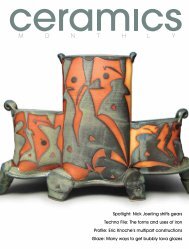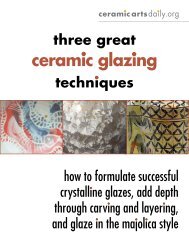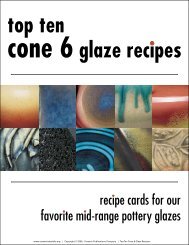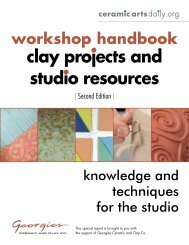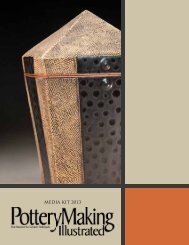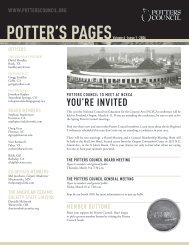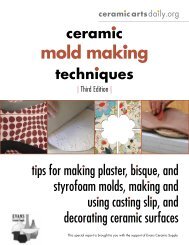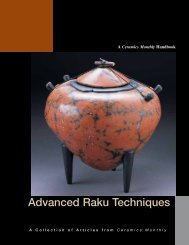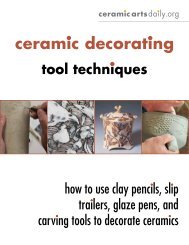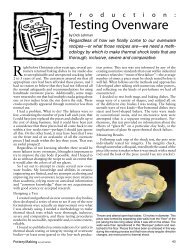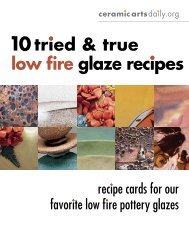Wood Firing Journeys and Techniques - Ceramic Arts Daily
Wood Firing Journeys and Techniques - Ceramic Arts Daily
Wood Firing Journeys and Techniques - Ceramic Arts Daily
Create successful ePaper yourself
Turn your PDF publications into a flip-book with our unique Google optimized e-Paper software.
With a Foreword by Dick Lehman<br />
A <strong>Ceramic</strong>s Monthly H<strong>and</strong>book<br />
<strong>Wood</strong> <strong>Firing</strong> <strong>Journeys</strong> <strong>and</strong> <strong>Techniques</strong><br />
A Collection of Articles from <strong>Ceramic</strong>s Monthly
<strong>Wood</strong> <strong>Firing</strong><br />
<strong>Journeys</strong> <strong>and</strong> <strong>Techniques</strong><br />
i
<strong>Wood</strong> <strong>Firing</strong><br />
<strong>Journeys</strong> <strong>and</strong> <strong>Techniques</strong><br />
A Collection of Articles from <strong>Ceramic</strong>s Monthly<br />
With a Foreword by Dick Lehman<br />
iii<br />
Published by<br />
The American <strong>Ceramic</strong> Society<br />
600 N. Clevel<strong>and</strong> Ave., Suite 210<br />
Westerville, Ohio 43082 USA<br />
The<br />
American<br />
<strong>Ceramic</strong><br />
Society
The American <strong>Ceramic</strong> Society<br />
600 N. Clevel<strong>and</strong> Ave., Suite 210<br />
Westerville, OH 43082<br />
© 2001, 2011 by The American <strong>Ceramic</strong> Society, All rights reserved.<br />
ISBN: 1-57498-143-9 (Paperback)<br />
ISBN: 978-1-57498-558-0 (PDF)<br />
No part of this book may be reproduced, stored in a retrieval system or transmitted in any form or by any means, electronic,<br />
mechanical, photocopying, microfilming, recording or otherwise, without written permission from the publisher, except by a<br />
reviewer, who may quote brief passages in review.<br />
Authorization to photocopy for internal or personal use beyond the limits of Sections 107 <strong>and</strong> 108 of the U.S. Copyright<br />
Law is granted by The American <strong>Ceramic</strong> Society, provided that the appropriate fee is paid directly to the Copyright<br />
Clearance Center, Inc., 222 Rosewood Drive, Danvers, MA 01923 U.S.A., www.copyright.com. Prior to photocopying items<br />
for educational classroom use, please contact Copyright Clearance Center, Inc. This consent does not extend to copyright<br />
items for general distribution or for advertising or promotional purposes or to republishing items in whole or in part in any<br />
work in any format. Requests for special photocopying permission <strong>and</strong> reprint requests should be directed to Director,<br />
Publications, The American <strong>Ceramic</strong> Society, 600 N. Clevel<strong>and</strong> Ave., Westerville, Ohio 43082 USA.<br />
Every effort has been made to ensure that all the information in this book is accurate. Due to differing conditions,<br />
equipment, tools, <strong>and</strong> individual skills, the publisher cannot be responsible for any injuries, losses, <strong>and</strong> other damages that<br />
may result from the use of the information in this book. Final determination of the suitability of any information, procedure<br />
or product for use contemplated by any user, <strong>and</strong> the manner of that use, is the sole responsibility of the user. This book is<br />
intended for informational purposes only.<br />
The views, opinions <strong>and</strong> findings contained in this book are those of the author. The publishers, editors, reviewers <strong>and</strong><br />
author assume no responsibility or liability for errors or any consequences arising from the use of the information contained<br />
herein. Registered names <strong>and</strong> trademarks, etc., used in this publication, even without specific indication thereof, are not to<br />
be considered unprotected by the law. Mention of trade names of commercial products does not constitute endorsement or<br />
recommendation for use by the publishers, editors or authors.<br />
Publisher: Charles Spahr, Executive Director, The American <strong>Ceramic</strong> Society<br />
Art Book Program Manager: Bill Jones<br />
Editor: Bill Jones<br />
Ebook Manager: Steve Hecker<br />
Graphic Design: Melissa Bury, Bury Design, Westerville, Ohio<br />
Graphic Production: David Houghton<br />
Cover Image: “<strong>Wood</strong>-fired Pitcher” by Robert Long<br />
iv
ConTenTs<br />
Foreword: It Is, After All, About the wood, right?<br />
by dick Lehman ........................................................................... vii<br />
It’s All one Meditation by Gil Stengel ............................................................1<br />
<strong>Wood</strong> firer shares thoughts on teaching <strong>and</strong> creating art.<br />
wood-Fire Apologia by Jane Herold ................................................................9<br />
Reasons for firing with wood.<br />
Magic <strong>and</strong> Ash by Barbara Campbell-Allen ...................................................11<br />
Altering paper clay shapes in an anagama.<br />
A Journey with Fire by Robert Long .............................................................14<br />
Reflections on the synthesis between wood firing <strong>and</strong> individual aesthetics.<br />
A New Collaboration by Dale Huffman ........................................................19<br />
Exploring <strong>and</strong> working with the idiosyncrasies of a wood-fired kiln.<br />
Larry davidson by Lyn Kidder ......................................................................24<br />
Self-sufficient New Mexico potter incorporates wood firing as part of a lifestyle.<br />
Brian VanNostr<strong>and</strong> by Phyllis Blair Clark ....................................................28<br />
Thirty years of research, diligence, <strong>and</strong> determination.<br />
Cary Hulin by Phyllis Blair Clark ..................................................................37<br />
Experiences in establishing a thriving pottery in Amish country.<br />
Joy Brown by Rich Pomerantz .......................................................................44<br />
Unglazed sculptures reveal the influence of Tamba wood-firing experience.<br />
Shiho Kanzaki: extending the Tradition by Dick Lehman .........................50<br />
Modern Japanese potter relates personal journey in the anagama tradition.<br />
wood <strong>Firing</strong> in Maryl<strong>and</strong> by Hollis L. Engley .............................................57<br />
Two potters construct a 65-cubic foot crossdraft wood-burning kiln.<br />
Nanban by Isamu Mizoguchi ..........................................................................65<br />
The construction <strong>and</strong> firing of a 33-foot long snake kiln.<br />
A Noborigama in the Colorado Mountains by Shelley Schreiber ...............71<br />
A Colorado potter builds <strong>and</strong> fires a three-chamber noborigama kiln.<br />
In My own Backyard by George (Kim) Ellington ........................................77<br />
North Carolina potter revives a local groundhog kiln tradition.<br />
Beyond the Light of the Sun <strong>and</strong> the Moon by Dick Lehman .....................83<br />
Potter finds fulfillment in Japanese-style wood firing.<br />
An Urban wood Kiln by Sam Clarkson ........................................................89<br />
Advice on firing a wood-burning kiln in the city.<br />
The Kiln That Consumed elkton ...............................................................93<br />
by Howard Kiefer with Deborah Lipman<br />
Saga of a third-generation Japanese-American potter who inspired<br />
a community to help build an anagama/noborigama kiln.<br />
v
Following Anagama Tradition by Estelle <strong>and</strong> Bruce Martin ........................98<br />
Two potters share their experiences in firing an anagama.<br />
The Incredible Hog Chain Groundhog by W. Lowell Baker .....................102<br />
Building <strong>and</strong> firing a traditional groundhog kiln in Mississippi.<br />
digging a Hillside Kiln by Bryson VanNostr<strong>and</strong> .........................................107<br />
Virginia potter uses available materials (<strong>and</strong> some<br />
friends) to dig a kiln into a seam of clay.<br />
A wood Kiln for the Lone Potter by David Swanson .................................110<br />
Small wood-burning kiln that can be fired by one person.<br />
Horn Isl<strong>and</strong> Kiln by W. Lowell Baker .........................................................112<br />
Building a low-cost, portable, high-fire wood kiln in the Greco-Roman tradition.<br />
A Kiln for All reasons by Barbara Johnson ................................................116<br />
Throwing a kiln? Eight students <strong>and</strong> two teachers build a wood-fired kiln<br />
with thrown cylinders.<br />
Clear Air by Gil Stengel ...............................................................................120<br />
A discussion of traditional wood firing in the age of the federal Clean Air Act.<br />
vi
It Is, After All,<br />
About the <strong>Wood</strong>, Right?<br />
had always hated Chinese elm trees. Could the powers of the universe have<br />
I created a more unlikable tree? I thought not!<br />
Too sparse to be called a shade tree, too leafy to be overlooked. A complainer of a tree,<br />
I think: remembering each wound, each scar, every nick <strong>and</strong> bruise, perpetually weeping<br />
from each of these traumas like an adolescent football player limping on each hurt, hoping<br />
to garner the sympathy of passers-by.<br />
A trash tree, really: insidiously, incessantly dropping brittle little branches every season of<br />
the year, never resting, nor allowing a moment’s rest for the caretaker of any yard containing<br />
its species.<br />
And why…why in the wisdom of the universe, would Nature have seen fit to program the<br />
physiology of these already unattractive trees with the biological imperative to have their<br />
massive trunks routinely split into two at a height of six or seven feet above the ground? Split,<br />
creating a crotch that collects rain <strong>and</strong> snow <strong>and</strong> wind-blown trash <strong>and</strong> rot, bugs <strong>and</strong> amphibians<br />
<strong>and</strong> reptiles <strong>and</strong> worms, bacteria <strong>and</strong><br />
fungus <strong>and</strong> mold. Split, creating a most<br />
unseemly soup of smells—a crotch stench<br />
so unpleasant that even our children avoid<br />
the beckoning branches of these trees in<br />
the heat of the summer—a rancidity of<br />
such putrescence that the mere description<br />
would be so indelicate as to be an injustice<br />
to one’s sensibilities. Split, ensuring<br />
that ultimately, in some season of small<br />
storms, the lightest wind <strong>and</strong> rain will<br />
cause those two cloven halves of the tree<br />
to move so far in opposite directions that<br />
inevitably both halves will crash to the<br />
ground in resignation—in a wind that<br />
would cause an oak barely to sniff or<br />
wince or shudder.<br />
And given such obvious inferiorities,<br />
who possibly could have thought it a<br />
good idea to import this Chinese cousin<br />
to the North American shores?<br />
And back to you, Mother Nature, if I<br />
may for just a moment: why would you<br />
have imparted upon this wretched ensemble of mediocrities the power to procreate in amplitudes<br />
surpassing almost all other trees? How many billions of incessant little rice crispy<br />
seeds are indeed needed each year to ensure the survival of the species?<br />
vii<br />
All photographs in this foreword are courtesy of Dick Lehman. These<br />
pots were wood fired with Chinese Elm trees for approximately 45<br />
hours to above Cone 10.
I never could forget the scores of ladder hours I had spent emptying my full gutters of<br />
soggy elm seeds. Nor would I ever forgive the seedy avalanche of the spring of 1996 that so<br />
clogged my gutters during an afternoon shower that my roof emptied its entire contents over<br />
the edge of my gutters, through my window wells, <strong>and</strong> into my basement. I came down the<br />
basement steps to spy a river of dirt <strong>and</strong> sludge that hosted hundreds of elm seeds blithely<br />
floating like miniature inner tubes across my basement, all seemingly oblivious to my distress.<br />
And I would hate to calculate how many hours, days, <strong>and</strong> weeks I have spent pulling<br />
Chinese elm seedlings from flower beds <strong>and</strong> rock gardens <strong>and</strong> strawberry patches <strong>and</strong> fern<br />
gardens <strong>and</strong> patio cracks…tenacious seedlings with long, deep-worming roots. And how is<br />
it that only weeks after tilling my entire garden, I discover young elm saplings, tall as my<br />
waist, hidden by the tall-staked tomato plants!<br />
And if the seeds <strong>and</strong> seedlings were not enough, consider how indiscrete a tree whose blanket<br />
of autumn leaves are, in their multitude,<br />
too large <strong>and</strong> dense to be allowed to remain<br />
upon the yard but, in their individuality, too<br />
small to be moved by normal raking.<br />
What was Mother Nature thinking?<br />
My disdain for these trees was further<br />
aroused when, upon moving to our new<br />
home, I discovered that the skinflinty<br />
l<strong>and</strong>scapers, instead of planting the<br />
pagoda dogwoods, the American<br />
beeches, the contorted filberts, the<br />
Japanese maples, the flowering crabs,<br />
the chestnuts, the mountain ashes<br />
that this lovely property invited, had<br />
instead merely thinned out the natural<br />
insurgence of Chinese elms to a few<br />
prime “specimens”—<strong>and</strong> left us with<br />
the decades of consequences.<br />
And so it was, years later, during one of<br />
those “seasons of small storms,” that five of<br />
these (now giant) “prime specimens” were<br />
felled by the slight breath of a springtime<br />
breeze <strong>and</strong> blocked our driveway, the road<br />
in front of our house, the side yard, but graciously<br />
spared our house <strong>and</strong> the kiln shed.<br />
But then a dilemma: What to do with all that wood? Me, a wood-firing potter. I would have<br />
liked nothing better than to have those trash trees hauled off to some l<strong>and</strong>-filled oblivion. But<br />
viii
oth my pride <strong>and</strong> my pocketbook<br />
intervened—could I, should I, might<br />
I, dare I!—try burning this wood in<br />
my kiln before making the expensive<br />
decision to pay someone else to haul<br />
it away?<br />
Begrudgingly, <strong>and</strong> with my moral<br />
tail between my legs, I decided first<br />
to try cutting, splitting, <strong>and</strong> burning<br />
before calling the “tree doctors.” But<br />
even in my resignation to these trees,<br />
they seemed to dem<strong>and</strong> a final <strong>and</strong> demeaning last word, holding out until the very end; their<br />
stringy, sinewy, tentacled flesh resisted the forces of the wood splitter. Sinking the splitter’s<br />
wedge at 12, 3, 6, <strong>and</strong> 9 o’clock—<strong>and</strong> from both ends of the logs—the cantankerous chunks<br />
required my best efforts before finally resigning to my own stubborn will. Just how is it, I wondered,<br />
that a tree so weak, so easily felled by the lightest of breezes, can possibly be incongruously<br />
so strong <strong>and</strong> difficult to split?<br />
I burned this wood I hated in my next firing. For 15 days I tossed into the firebox wood<br />
that however quirky had ultimately been true to its biological imperative (<strong>and</strong> subject to the<br />
particularities of the roughly 200 cubic yards of soil through which its roots had grown),<br />
wood that had quietly <strong>and</strong> steadily stored away in its bark <strong>and</strong> cambium layer a particular set<br />
of soluble minerals <strong>and</strong> salts. And as I burned this hated elm, minuscule amounts of these<br />
minerals <strong>and</strong> salts hitchhiked on the fly ash <strong>and</strong> began a journey through the kiln. The ash<br />
swirled <strong>and</strong> eddied around the pots, was lifted by the heat of combustion to higher elevations<br />
within the kiln, then, cooling a bit, began to descend through the pots <strong>and</strong> shelves, being<br />
inexorably pulled by the chimney’s draft to a small exit flue hole at the bottom of the kiln.<br />
And if, by some chance of the swirling currents within the kiln, the fly ash avoided direct<br />
contact with the pots, it exited the chimney <strong>and</strong> eventually returned to the earth to fertilize<br />
another generation (God forbid) of Chinese elms.<br />
But some of the fly ash, during its dance among the pots, came in direct contact with the<br />
red-hot molten sticky pot surfaces, leaving the smallest imaginable trace of flux <strong>and</strong> hitchhiking<br />
glaze chemistry on the surface of the pots. And after 15 days, there began to collect<br />
a formidable swell of these glaze-making traces, emerging as an oozing sticky mass of improbable<br />
collaborators.<br />
It was then as the pyroplasticity of the clay caused the clay to soften, as the natural ash accumulations<br />
melted <strong>and</strong> softened the contours of the pots, it was then that my heart softened<br />
as well. It dawned on me that these pots, fired with this fuel, were perhaps more mine than any<br />
others I would ever make: precisely because of the Chinese elm. These trees had patiently,<br />
over a series of decades, grown on my l<strong>and</strong>, absorbed the nutrients <strong>and</strong> solubles from my<br />
soil, been subject to the seasons of my climate. Then, in the journey of the firing, these trees<br />
had given back to my pots the very solubles they had taken from my soil.<br />
ix
And the giving back was not unspectacular, ranging from white, yellow, gold, <strong>and</strong> pastel<br />
pink crystal formations to orange, green, brown, blue, blue-gray, <strong>and</strong> aquamarine glaze<br />
runs. Textures ranged from dry ash-encrusted deserts to glassy smooth pools. The Chinese<br />
elm ash deposits caused the topographical surfaces of my large-orbed works to appear as<br />
mountains <strong>and</strong> deserts <strong>and</strong> seas on some distant planet. What a remarkable paradox!<br />
I no longer hate Chinese elm trees; they are now part of my technique. They have joined<br />
me on this wood-firing journey. I can no longer bring my heart to harbor them ill will, despite<br />
the quirky idiosyncrasies with which Mother Nature has endowed these hapless giants.<br />
Instead, I live in gratitude that reflects my passion. Gratitude, because wood-firing is, after<br />
all, all about the wood, right?<br />
What follows is a remarkable collection of writings by <strong>and</strong> about contemporary wood-firing<br />
potters. These stories offer us an international glimpse of the techniques that motivate <strong>and</strong><br />
the journeys that inspire these clay artists. But a deeper investigation may reveal to you that<br />
these writings, these lives, these works are about more than just journeys <strong>and</strong> techniques.<br />
These writings reveal passions that both express <strong>and</strong> give meaning to life <strong>and</strong> work. Listen,<br />
for a moment, to some of the words <strong>and</strong> ideas that grace these articles.<br />
At times, it is clear to me that these authors are reflecting upon both the firing process <strong>and</strong><br />
the pots themselves: We hear them speak of the soft sound of the crackling fire, their urgings<br />
to be inventive, to “think like the<br />
flame.” They convey their awareness of<br />
the community that exists among potters<br />
<strong>and</strong> the importance of bringing together<br />
a synergistic group of artisans. They confess<br />
a desire of “going beyond ‘common<br />
sense’ toward listening to the…voice of<br />
the fire <strong>and</strong> the voice of the clay.”<br />
We hear expressions of hope that clay<br />
artists will be able to create work “with<br />
a voice of its own, something that can’t<br />
really be duplicated,” pots that reveal<br />
firing history through the “search for that<br />
synthesis between my own aesthetic <strong>and</strong> the fire’s.” One author confided that “truly good<br />
pots owe more to the generosity <strong>and</strong> spirit with which they are made.” Others disclose their<br />
conviction that the best pots “go beyond their grounding in intellectual underst<strong>and</strong>ing,” <strong>and</strong><br />
become works that “enliven the spirit.”<br />
At other times within these writings, it seems less clear to me: are the authors speaking about<br />
pots or life, or both? What is the focus of their reflections about beauty, pleasure, sensuousness,<br />
hope, <strong>and</strong> wistfulness? And of what are they speaking when they mention collaboration,<br />
teamwork, hospitality? The rich intermingling between work (noun) <strong>and</strong> work (verb)<br />
invites one to fantasize for more than a moment with “power <strong>and</strong> sophisticated beauty,” “a<br />
x
means of exploring relationships,” or<br />
“focus tempered with affection.” Is it<br />
descriptive or autobiographical when<br />
we read of technique following one’s<br />
heart <strong>and</strong> soul, “overcoming difficulties<br />
as a revelation of true beauty,” or<br />
the blushing confession of “an indescribable<br />
difference in soul?”<br />
And finally, I have come to the inescapable conclusion that at times these writers are speaking<br />
of an inextricable synthesis of pot <strong>and</strong> process <strong>and</strong> person: I hear these echoes: “I can<br />
shape the life I create,” “pleasure in everyday living,” “an expression of one’s self <strong>and</strong> one’s<br />
values,” all of life as “one meditation,” <strong>and</strong> “discipline which allows the spiritual, physical,<br />
<strong>and</strong> emotional parts of life to balance <strong>and</strong> integrate...to become more whole…to discover<br />
what life is all about.”<br />
Other authors are even more bold, describing this synthesis as “not being bound…by the<br />
definitions of common sense,” works <strong>and</strong> work <strong>and</strong> life that go “beyond the light of the sun<br />
<strong>and</strong> the moon” that are simply “an embarrassment of riches,” for which there is nothing but<br />
gratitude!<br />
These wood-firing potters grace us with a glimpse of the passions that inform their technique<br />
<strong>and</strong> journey. In the words of my dear friend Mr. Shiho Kanzaki, “As artists, it is our responsibility<br />
to always pursue a better thing.” Indeed the passions are the journey.<br />
—Dick Lehman<br />
xi
When I was a young man study-<br />
ing ceramics at the University<br />
of Louisville, Tom Marsh used to read<br />
to the classes quite a bit. One day he<br />
was reading some prose by Gary Snyder.<br />
I can’t remember the book now, or<br />
the exact reference, but in this excerpt,<br />
Snyder was talking about his experiences<br />
in a Zen monastery in Japan.<br />
It seems that one of Snyder’s jobs was<br />
to work in the monastery vegetable<br />
garden. After a few months, he realized<br />
that with some changes the garden<br />
Faceted vase, 5 inches in height, wood-fired stoneware.<br />
It’s All One Meditation<br />
by Gil Stengel<br />
could be more efficiently worked to<br />
provide more free time <strong>and</strong> higher<br />
yield. He proposed these changes to<br />
the monk in charge of gardening <strong>and</strong><br />
was rebuked.<br />
The monk said something along the<br />
lines of: “Why do you want to make<br />
the gardening more efficient to save<br />
time? You will only have to spend that<br />
much more time meditating <strong>and</strong> your<br />
knees will hurt more.”<br />
The lesson the monk wished to<br />
impart to Snyder was simple, really:<br />
Whether he was working in the<br />
garden, praying, studying, eating or<br />
sleeping—it was all the same thing.<br />
They were all one meditation.<br />
A few years later, I went camping<br />
with my brother-in-law in Kentucky’s<br />
Red River Gorge. Over a few whiskeys<br />
around the fire, he posed a question<br />
that he at first would not answer:<br />
“What is the true way of Zen?” It took<br />
a few days for me to drag this answer<br />
from him. I will never forget it. “Eat<br />
when you are hungry. Drink when you<br />
are thirsty. Sleep when you are tired.”<br />
I cite these two stories from my<br />
1 <strong>Journeys</strong> <strong>and</strong> <strong>Techniques</strong>
“Watering Can,” 11 inches in height, porcelain, wood/salt fired.<br />
<strong>Wood</strong> <strong>Firing</strong> 2
Porcelain platter, 23 inches in diameter,<br />
with copper red glaze.<br />
early adult years because they have<br />
helped shape the man I am today. I<br />
have striven until the sweat poured<br />
from my body to make all things “one<br />
meditation,” only to find that the<br />
answer is elusive, couched probably<br />
in the act of striving.<br />
When I was younger, I had this<br />
naïve idea that “one meditation”<br />
meant living in the woods <strong>and</strong> silently<br />
moving from task to task in a perfect<br />
studio, achieving some state of tranquility<br />
where the world was tuned out<br />
<strong>and</strong> had no meaning. I even created<br />
that place <strong>and</strong> tried to create that very<br />
life, so deep was my conviction <strong>and</strong><br />
my naïveté. I hoped that working in<br />
clay would bring me closer to what<br />
both stories represent.<br />
I have since learned that my entire<br />
life is the clay, that simply choosing a<br />
trade had little to do with the truth I<br />
sought. If all is one meditation—<strong>and</strong><br />
I believe that to be true—then how<br />
is working in clay any different than<br />
working on a turret lathe? I don’t<br />
believe the two are different. I don’t<br />
believe that I (or any other artist) am<br />
any different than anyone else walking<br />
down the street, scratching him- or<br />
herself, living one meditation.<br />
I’ve spent a lot of time talking<br />
to my students about a st<strong>and</strong>ard.<br />
Somehow, living one meditation <strong>and</strong><br />
knowing one st<strong>and</strong>ard are connected.<br />
I’ll try to explain: In A Potter’s Book,<br />
Bernard Leach proposed some very<br />
explicit ideas about setting a st<strong>and</strong>ard<br />
in pottery. He spoke to this point very<br />
eloquently in the chapter “Towards<br />
a St<strong>and</strong>ard.” I have been thinking<br />
about that st<strong>and</strong>ard for many years.<br />
St<strong>and</strong>ards of beauty pervade every<br />
Faceted vase, 9 inches in height, stoneware, wood/salt fired.<br />
part of my life. When I talk about<br />
st<strong>and</strong>ards to my students they all want<br />
a definition, a formula on how to meet<br />
these st<strong>and</strong>ards; however, the concept<br />
is not so quickly attained.<br />
There is a movie on Shoji Hamada<br />
<strong>and</strong> Bernard Leach that was filmed in<br />
1974. I’ve seen that movie, Art of the<br />
Potter, probably close to a hundred<br />
times. Tom Marsh used to show it every<br />
semester to every class, <strong>and</strong> I do the<br />
same at Western Illinois University. In<br />
it there is a brief section where Hamada<br />
is being interviewed <strong>and</strong> in English<br />
he says quite clearly (I know because I<br />
rewound this part three times): “Some<br />
people try to measure the st<strong>and</strong>ard<br />
with a rule. That is a very big mistake.”<br />
That is as good an explanation of how<br />
to define this st<strong>and</strong>ard as anything I<br />
have ever heard or read.<br />
Now, here is the funny thing—I’ve<br />
watched that movie countless times. I<br />
know the dialogue so well that I’ve even<br />
parodied parts of it with friends. Yet I<br />
first really heard those words about a<br />
year ago. Why is that? I was literally<br />
floored <strong>and</strong> almost wept with relief on<br />
hearing those words; they were like a<br />
soothing h<strong>and</strong> on my troubled brow.<br />
3 <strong>Journeys</strong> <strong>and</strong> <strong>Techniques</strong>
Yet I had to watch that film a hundred<br />
times to hear that sentence. Why?<br />
Because my life is the clay. I can’t hear<br />
what I am not ready to hear. I can’t<br />
hear something I can’t underst<strong>and</strong>. For<br />
some reason, I had to be 37 years old<br />
in an old gymnasium on the campus<br />
of Western Illinois University to hear<br />
<strong>and</strong> underst<strong>and</strong> those words.<br />
How can I teach these things to my<br />
students? I cannot tell them the things<br />
they are not ready to hear. Their lives<br />
are the clay. They are no different than<br />
I. I don’t have a formula for explaining<br />
a st<strong>and</strong>ard to them. They have to live<br />
their lives <strong>and</strong> know this in their own<br />
way. The concept doesn’t fit higher<br />
education; it isn’t multicultural, politi-<br />
Large vessel, 35 inches in height, wheel-thrown<br />
stoneware, wood fired.<br />
cally correct, paradigm-shift material.<br />
It is a simple fact of living your life, of<br />
gaining experience, of working hard<br />
on whatever presents itself. I would<br />
love to be able to simply write down<br />
what that st<strong>and</strong>ard is, but the best I<br />
can do is relate one curious experience<br />
I have had that has helped me<br />
to know it.<br />
I have a friend in Davenport, Iowa,<br />
who is a student in clay. He comes<br />
down to help fire our wood-burning<br />
kiln. He’s hooked, you see. You’ve seen<br />
it, felt it—you know what I mean. He<br />
has come to clay later in life than most,<br />
but he has an advantage over younger<br />
students in that he has already learned<br />
living <strong>and</strong> is ready to learn seeing. We<br />
<strong>Wood</strong> <strong>Firing</strong> 4<br />
have had some long conversations<br />
about st<strong>and</strong>ards. These conversations<br />
grew out of my telling him about a<br />
teaching experience I had where I had<br />
offered a student some criticism of a<br />
technical nature—you know, change<br />
this foot so, lower this form break,<br />
etc. After the critique, the student immediately<br />
said, “Well, that’s just your<br />
opinion.”<br />
I have tried to explain to my friend<br />
in Davenport <strong>and</strong> to my students that<br />
no, this is not simply my opinion. I<br />
didn’t just make it up on the spot, pull<br />
it out of thin air.<br />
Let me offer an example from my<br />
days as a student pilot: You are in the<br />
front seat of a glider, instructor behind,
<strong>and</strong> you are on final approach to l<strong>and</strong>.<br />
You do a reasonable job. After all, you<br />
make it down in one piece, are able to<br />
walk away, as they say in flying. But<br />
your instructor isn’t done. He’s criticizing<br />
your h<strong>and</strong>ling of the airplane.<br />
You trimmed your l<strong>and</strong>ing pattern<br />
inappropriately. You pulled spoilers<br />
too soon. You were too low over the<br />
trees on final, etc. Is this just his opinion?<br />
Did he make this up? Given the<br />
same combination of mistakes under<br />
different conditions, <strong>and</strong> you might<br />
very well find yourself dead.<br />
Similarly in pots, is a st<strong>and</strong>ard<br />
merely opinion? Is the pot alive or<br />
dead?<br />
I was recently invited by Dan An-<br />
Large vessel, 35 inches in height,<br />
wood-fired stoneware.<br />
derson at Southern Illinois University<br />
in Edwardsville to participate in some<br />
critiques <strong>and</strong> show slides afterward.<br />
Now this for me is an intimidating<br />
thing. I’m not the most eloquent or<br />
verbal person in a critique. I admire<br />
those who seem to effortlessly know<br />
<strong>and</strong> underst<strong>and</strong> the work before them.<br />
Me, I have to wrack my brain. It’s<br />
exhausting.<br />
I remember one student in particular<br />
who had put out both pots<br />
<strong>and</strong> sculptural pieces. I asked him,<br />
“Why this dichotomy in your work?”<br />
I thought I was being smart. Dan Anderson<br />
stopped the whole show <strong>and</strong><br />
explained to me very patiently that<br />
dichotomy was explicitly encouraged<br />
at SIUE. It seems he doesn’t think<br />
there are enough pots in the world,<br />
that students learn just as much about<br />
working the clay <strong>and</strong> the sculptural issues<br />
therein by making pots as making<br />
anything else.<br />
Well, there are experiences <strong>and</strong><br />
there are experiences, but right there<br />
I felt like someone had hit me on the<br />
forehead with a 2×4. Why couldn’t<br />
I see that all those years? In my own<br />
work, I had worried about going back<br />
<strong>and</strong> forth from large sculptural vessel<br />
forms to intimate porcelain teapots.<br />
I had always assumed that this split<br />
personality in the studio was a bad<br />
thing, <strong>and</strong> here someone was calmly<br />
telling me that no, this is the thing. I<br />
5 <strong>Journeys</strong> <strong>and</strong> <strong>Techniques</strong>
83.3<br />
Main firebox<br />
area 63<br />
A. P. Green<br />
KX–99 Firebrick<br />
“Watering Can,” 9 inches in height, stoneware,<br />
soda fired.<br />
have been a different man since.<br />
I have been making most of my<br />
forms for years. I’m not sure why that<br />
is, <strong>and</strong> I sometimes think that is a<br />
bad thing, too. You see, I was raised<br />
in suburban America. I was taught to<br />
like new things, original things. I still<br />
have trouble with the idea that making<br />
something over <strong>and</strong> over isn’t original,<br />
even though I know that when I repeat<br />
a form, no two are really alike <strong>and</strong>, yes,<br />
I’ve read The Unknown Craftsman. I’m<br />
still trying to sort this out.<br />
Castable<br />
Side view cutaway of two-chamber wood-burning kiln.<br />
I had a period about seven years ago<br />
where it seemed that the forms I was<br />
making were starting to click. I don’t<br />
know why, but for about a year in<br />
my studio in Kentucky, for no reason<br />
that I could see, my pots just seemed<br />
to come together a little better than<br />
usual. I hadn’t experienced such a time<br />
before (or since) <strong>and</strong> I have continued<br />
to draw on the library of pieces I<br />
designed during that period. Just recently,<br />
I’ve started to design some new<br />
forms again, but I haven’t achieved<br />
the flow of work that I seemed to tap<br />
into then.<br />
Usually, when I see a surface that<br />
speaks to me, I immediately think of<br />
how I can work one of my forms to<br />
take advantage of that surface. I’m always<br />
looking for surfaces, usually from<br />
some area of the kiln that is perceived<br />
as a problem. This sort of design exercise<br />
is what gets me out of bed in the<br />
morning. As I alluded to earlier, I have<br />
a tendency to go back <strong>and</strong> forth in<br />
the studio, first working a long run of<br />
large-scale coiled-<strong>and</strong>-thrown vessels,<br />
then moving back to smaller, more<br />
intimately scaled utilitarian pieces.<br />
I use a heavily grogged stoneware<br />
body for the large work. I purchased<br />
some 4- <strong>and</strong> 5-mesh grog from A. P.<br />
Green. It’s great but is very hard on the<br />
skin when thrown; however, I’ve found<br />
<strong>Wood</strong> <strong>Firing</strong> 6<br />
61.3<br />
44.8<br />
207.1<br />
Vertical<br />
“guillotine”<br />
damper<br />
Chimney height<br />
approximately<br />
15 feet<br />
this to be the best insurance against<br />
losing large pieces in the firing. I like<br />
the texture, too.<br />
The following are some clay <strong>and</strong><br />
glaze recipes I use in the studio. I’m<br />
not very particular, but these seem to<br />
work well here in western Illinois. I try<br />
hard to take advantage of the materials<br />
<strong>and</strong> kilns that are available.<br />
WIU Class Stoneware Body<br />
(Cone 9–10)<br />
Custer Feldspar ........................ 16
First<br />
chamber<br />
firebox<br />
4.5<br />
Grolleg Porcelain Body<br />
(Cone 9–10)<br />
Custer Feldspar ........................ 18 %<br />
Grolleg Kaolin .......................... 55<br />
Flint ......................................... 14<br />
Molochite 200 ........................... 8<br />
Pyrophyllite ............................... 5<br />
100 %<br />
Add 2% bentonite, blunged in water.<br />
Seaslug White Glaze*<br />
(Cone 9–10)<br />
Bone Ash .............................. 2.04 %<br />
Talc ...................................... 7.14<br />
Whiting .............................. 19.39<br />
Custer Feldspar ................... 32.6
When Stengel “was younger, I had this naïve idea that ‘one meditation’ meant living in the woods <strong>and</strong> silently moving from<br />
task to task in a perfect studio.”<br />
rangement <strong>and</strong> ratio of chambers to<br />
firebox area.<br />
The WIU version is fired in about<br />
35 to 40 hours, using sawmill scrap. I<br />
particularly enjoy stoking at 4 AM <strong>and</strong><br />
watching dawn break. I sometimes try<br />
to cook breakfast for the crew. Like me,<br />
most of them are never normally awake<br />
at such an hour.<br />
Currently, a section of our wood<br />
kiln appears to be causing the clay to<br />
trap carbon; at the same time, the salt<br />
is hitting the wood ash <strong>and</strong>, combined<br />
with the clay underneath, is turning<br />
yellow. I think this has potential. The<br />
combination is dramatic; however, it is<br />
difficult to make a piece strong enough<br />
to st<strong>and</strong> with this wild surface. The yellow<br />
<strong>and</strong> gray combination blows your<br />
eye away, <strong>and</strong> you miss the form.<br />
If someone were to force me to pick<br />
just one narrow area in which to work<br />
for the rest of my “clay life,” I would<br />
probably choose salt-fired porcelain. I<br />
like the way salt freezes the action of<br />
clay in a potter’s h<strong>and</strong>s. There is an<br />
endless subtlety to the movement of<br />
fingers through porcelain that I never<br />
tire of seeing. ▲<br />
<strong>Wood</strong> <strong>Firing</strong> 8<br />
Large stoneware vessel, 35 inches in height,<br />
by Gil Stengel, Macomb, Illinois.



